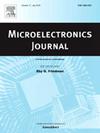A low-jitter charge-pumped PLL for LiDAR detectors
IF 1.9
3区 工程技术
Q3 ENGINEERING, ELECTRICAL & ELECTRONIC
引用次数: 0
Abstract
A low-jitter charge-pumped phase-locked loop (CPPLL) with four-stage differential delay units is implemented in 180 nm standard CMOS technology. Not only a current-steering technique is adopted to eliminate charge injection and clock feed-through effects, but also a frequency divider with a retiming structure is used to ensure the high accuracy of the system feedback loop. The voltage-controlled oscillator adopts a gated-ring structure to achieve a stable and controllable clock. The prototype of the CPPLL occupies 0.184 , and results reveal that when the reference clock is 50 MHz, the output frequency is locked at 800 MHz accurately. The phase noise is as low as −140 dBc/Hz @1 MHz, with a peak-to-peak jitter of 4.36 ps. Meanwhile, an ultra-low root-mean-square (RMS) jitter of 0.161 ps is obtained. At the output spectrum of 800 MHz, the reference spur is merely −72 dBc. These results highlight the CPPLL's outstanding performance in phase noise, jitter, and stability, making it well-suited for high-precision integrated LiDAR.
求助全文
约1分钟内获得全文
求助全文
来源期刊

Microelectronics Journal
工程技术-工程:电子与电气
CiteScore
4.00
自引率
27.30%
发文量
222
审稿时长
43 days
期刊介绍:
Published since 1969, the Microelectronics Journal is an international forum for the dissemination of research and applications of microelectronic systems, circuits, and emerging technologies. Papers published in the Microelectronics Journal have undergone peer review to ensure originality, relevance, and timeliness. The journal thus provides a worldwide, regular, and comprehensive update on microelectronic circuits and systems.
The Microelectronics Journal invites papers describing significant research and applications in all of the areas listed below. Comprehensive review/survey papers covering recent developments will also be considered. The Microelectronics Journal covers circuits and systems. This topic includes but is not limited to: Analog, digital, mixed, and RF circuits and related design methodologies; Logic, architectural, and system level synthesis; Testing, design for testability, built-in self-test; Area, power, and thermal analysis and design; Mixed-domain simulation and design; Embedded systems; Non-von Neumann computing and related technologies and circuits; Design and test of high complexity systems integration; SoC, NoC, SIP, and NIP design and test; 3-D integration design and analysis; Emerging device technologies and circuits, such as FinFETs, SETs, spintronics, SFQ, MTJ, etc.
Application aspects such as signal and image processing including circuits for cryptography, sensors, and actuators including sensor networks, reliability and quality issues, and economic models are also welcome.
 求助内容:
求助内容: 应助结果提醒方式:
应助结果提醒方式:


